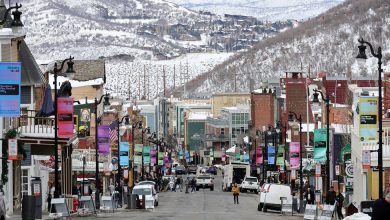Failure to Slow Warming Will Set Off Climate ‘Tipping Points,’ Scientists Say

Failure to limit global warming to the targets set by international accords will most likely set off several climate “tipping points,” a team of scientists said on Thursday, with irreversible effects including the collapse of the Greenland and West Antarctic ice sheets, abrupt thawing of Arctic permafrost and the death of coral reefs.
The researchers said that even at the current level of warming, about 1.1 degrees Celsius (2 degrees Fahrenheit) above preindustrial levels, some of these self-sustaining changes might have already begun. But if warming reached above 1.5 degrees Celsius, the more ambitious of two targets set by the 2015 Paris Agreement, the changes would become much more certain.
And at the higher Paris target, 2 degrees Celsius, even more tipping points would likely be set off, including the loss of mountain glaciers and the collapse of a system of deep mixing of water in the North Atlantic.
The changes would have significant, long-term effects on life on Earth. The collapse of the Greenland and West Antarctic ice sheets, for example, would lead to unrelenting sea level rise, measured in feet, not inches, over centuries. The thawing of permafrost would release more heat-trapping gases into the atmosphere, hindering efforts to limit warming. A shutdown of ocean mixing in the North Atlantic could affect global temperatures and bring more extreme weather to Europe.
Johan Rockström, the director of the Potsdam Institute for Climate Impact Research in Germany and one of the researchers, said the team had “come to the very dire conclusion that 1.5 degrees Celsius is a threshold” beyond which some of these effects would start. That makes it all the more imperative, he and others said, for nations to quickly and drastically cut emissions of carbon dioxide and other heat-trapping gases to curb global warming.
The research is in line with recent assessments by the Intergovernmental Panel on Climate Change, a group of experts convened by the United Nations, that beyond 1.5 degrees of warming, the threats of climate change grow considerably.
“It really provides strong scientific support for rapid emission cuts in line with the Paris Agreement,” said David Armstrong McKay, a climate scientist at the University of Exeter in Britain and the lead author of a paper describing the researchers’ work, published in Science. Limiting warming to 1.5 degrees “doesn’t guarantee we don’t see tipping points,” Dr. McKay said. “But it reduces the likelihood.”
And as with the U.N. panel’s assessments, overshooting the 1.5 degree target does not mean all is lost. “Every 10th of a degree counts,” Dr. Rockström said. “So 1.6 is better than 1.7 and so on” in reducing the tipping-point risks.
Countries have not pledged to cut greenhouse gas emissions enough to meet either Paris target, although the climate and energy legislation passed by Congress last month moves the United States much closer to its own goals. Current policies put the world on pace for nearly 3 degrees Celsius of warming by the end of the century. At that level of warming, even more tipping points would be set off, the researchers said.
The concept of climate tipping points has been around for decades. But it has also been accompanied by a high degree of uncertainty and debate, including about the threshold temperatures beyond which some changes would begin, and whether some of these events even meet the definition of changes that would be self-sustaining no matter what happens with future warming.
A major study in 2008 identified more than a dozen parts of Earth’s system that could reach a tipping point. The new research eliminated a few and added several more, identifying a total of 16 parts, including nine that would have global effects.
Among those eliminated, Dr. McKay said, was summer Arctic sea ice. Although ice extent has been steadily declining for decades, he said there was not any clear threshold beyond which the decline would become self-sustaining.
But the main goal of the new research, which reviewed studies that had used data from past climates, current observations and computer simulations, was to reduce the uncertainty about when the tipping points might be reached.
The study “puts temperature thresholds on all the tipping elements,” Dr. Rockström said. “That has never been done before.”
Bill Hare, who is the chief executive of Climate Analytics, a nonprofit research and policy organization, and who was not involved in the study, said, “It systematically puts together and synthesizes the state of scientific knowledge about critical Earth system tipping points.”
“It reinforces the urgency of the global community working together to halve emissions by 2030 and get to net zero by 2050,” he said.
Thomas Stocker, a climate scientist at the University of Bern in Switzerland who was not involved in the study, cautioned that much more research was needed on the subject of tipping points. “It’s not the ultimate word,” he said of the study’s findings. “It’s a contribution to an important conversation that is ongoing.”
What is needed, Dr. Stocker said, is a comprehensive analysis by the Intergovernmental Panel on Climate Change, perhaps as part of the next round of assessments, which is due in the second half of this decade.
Dr. Rockström agreed that more research was needed. “I’m hoping that the I.P.C.C. will take this scientific assessment on board,” he said.
The Potsdam institute and the University of Exeter are also sponsoring a conference next week designed to encourage more work on the subject. Among other projects, Dr. Rockström said, is one to improve modeling of these cataclysmic events.
“We’re in a much better position now than just a few years back to advance a real initiative on tipping point research,” he said.




